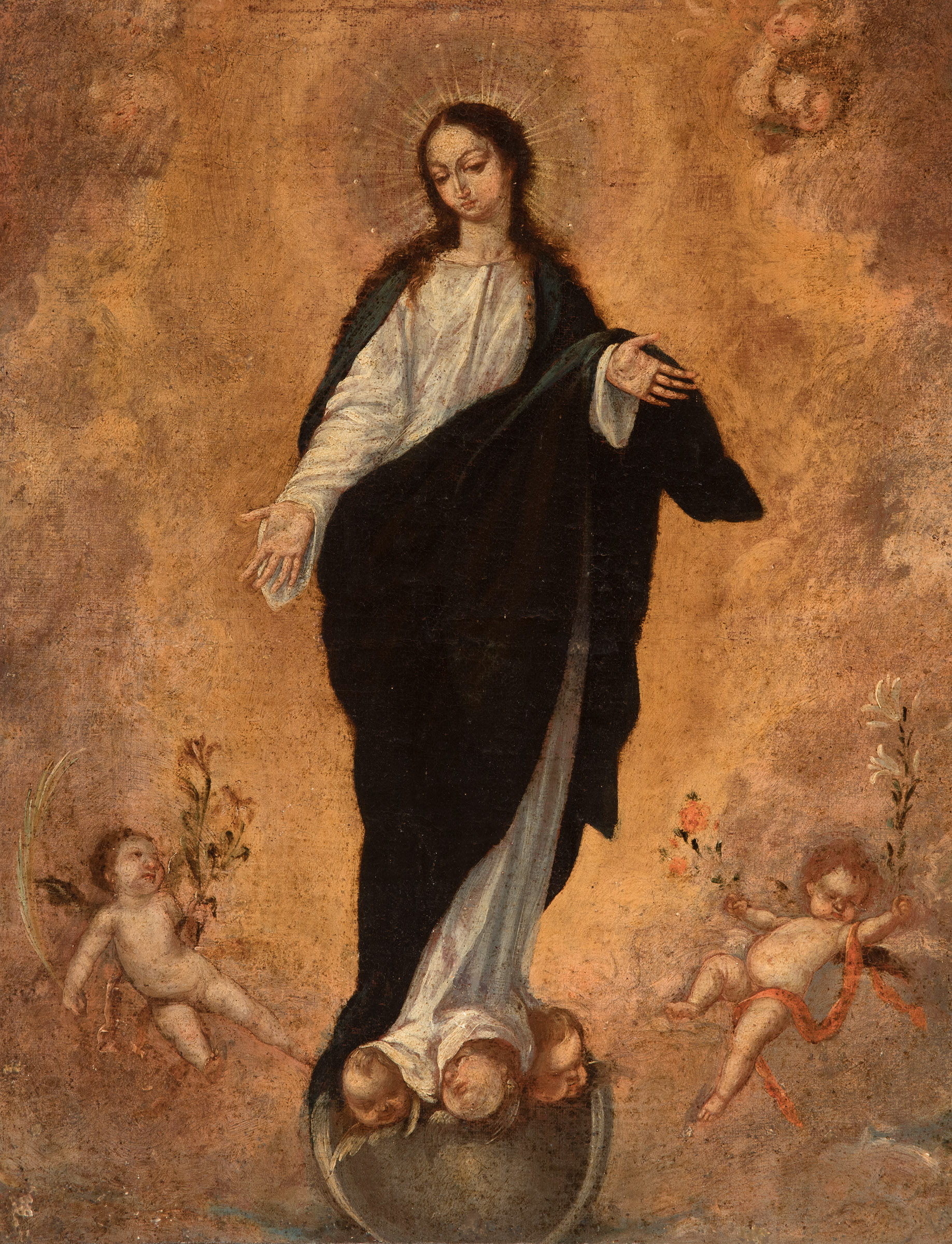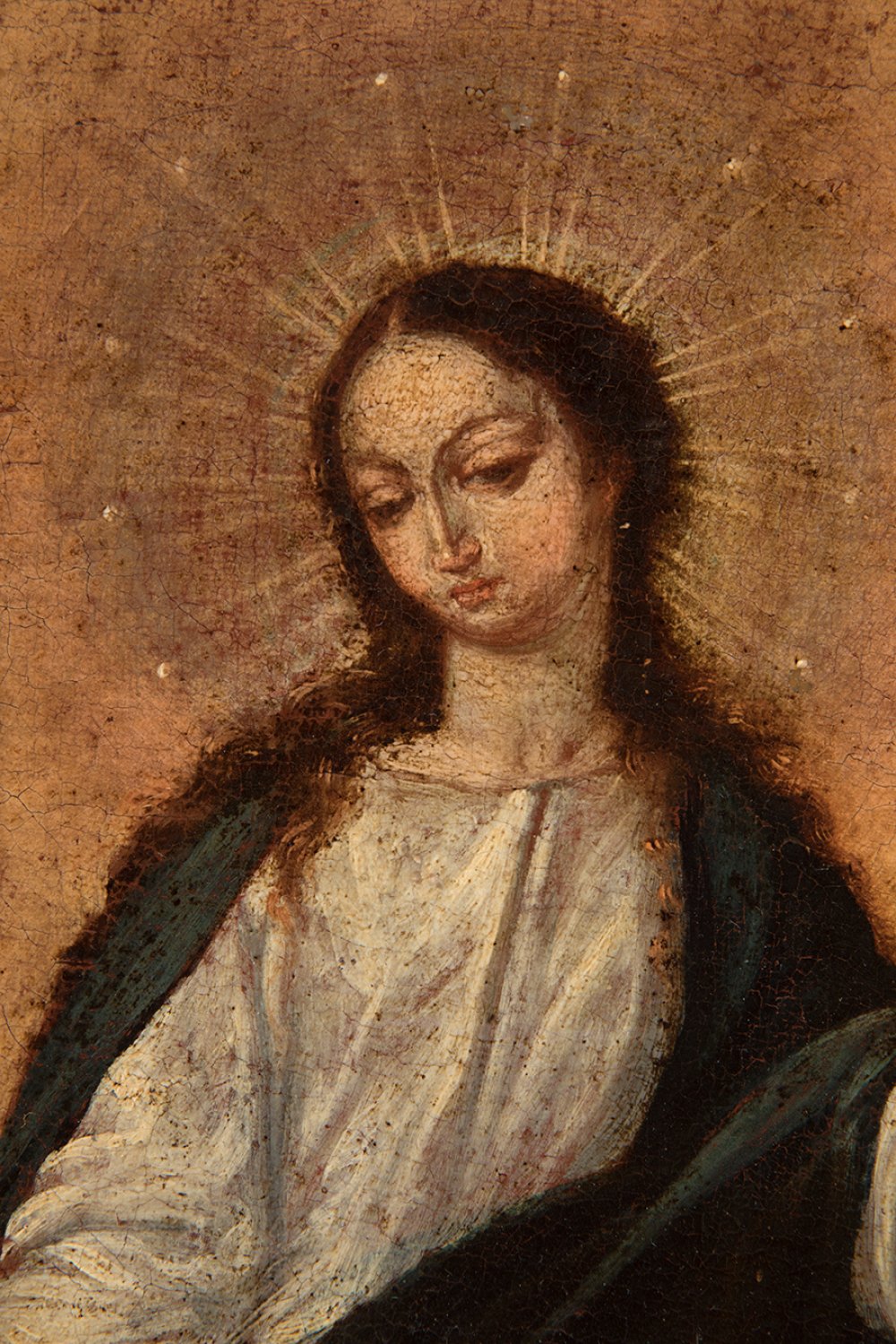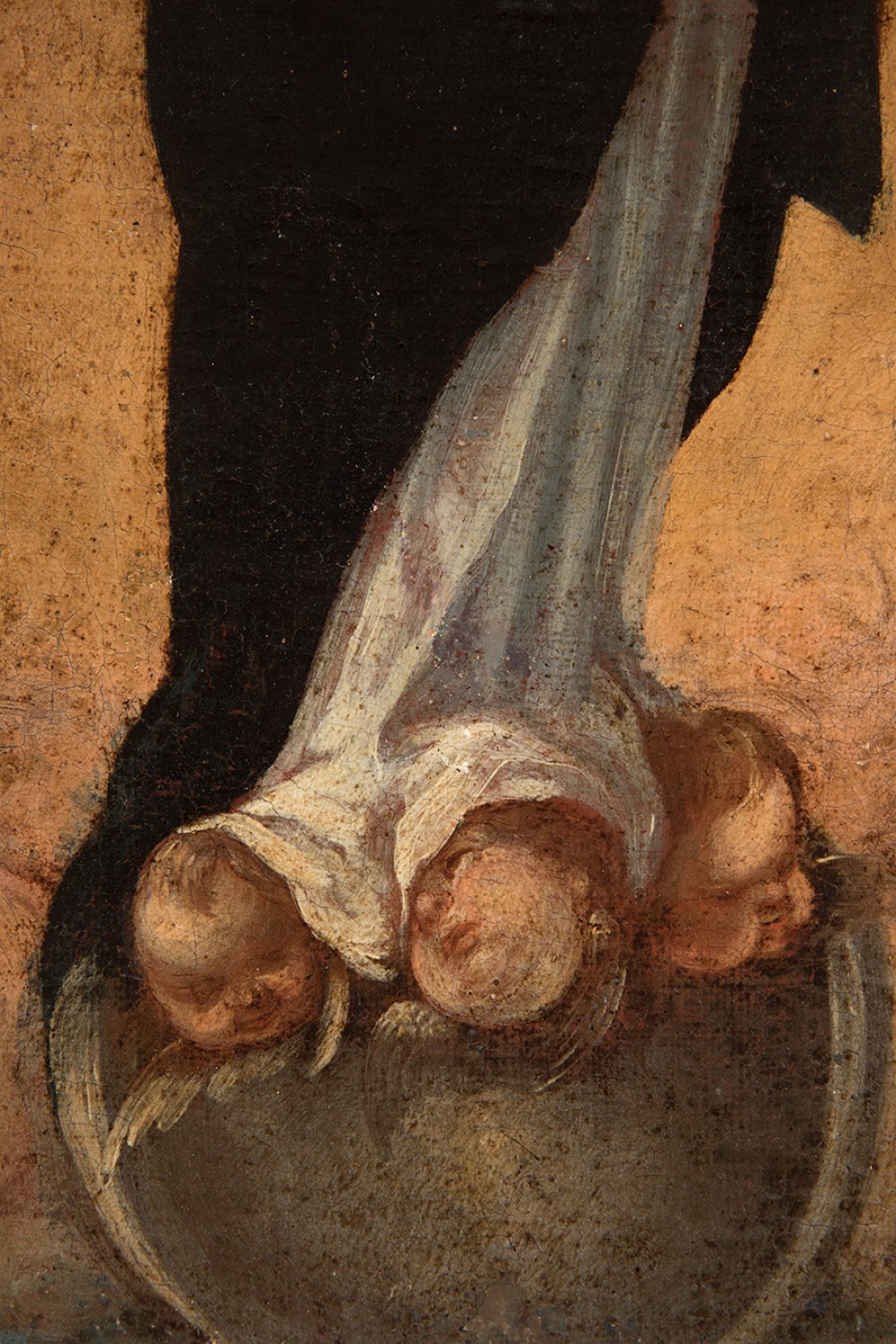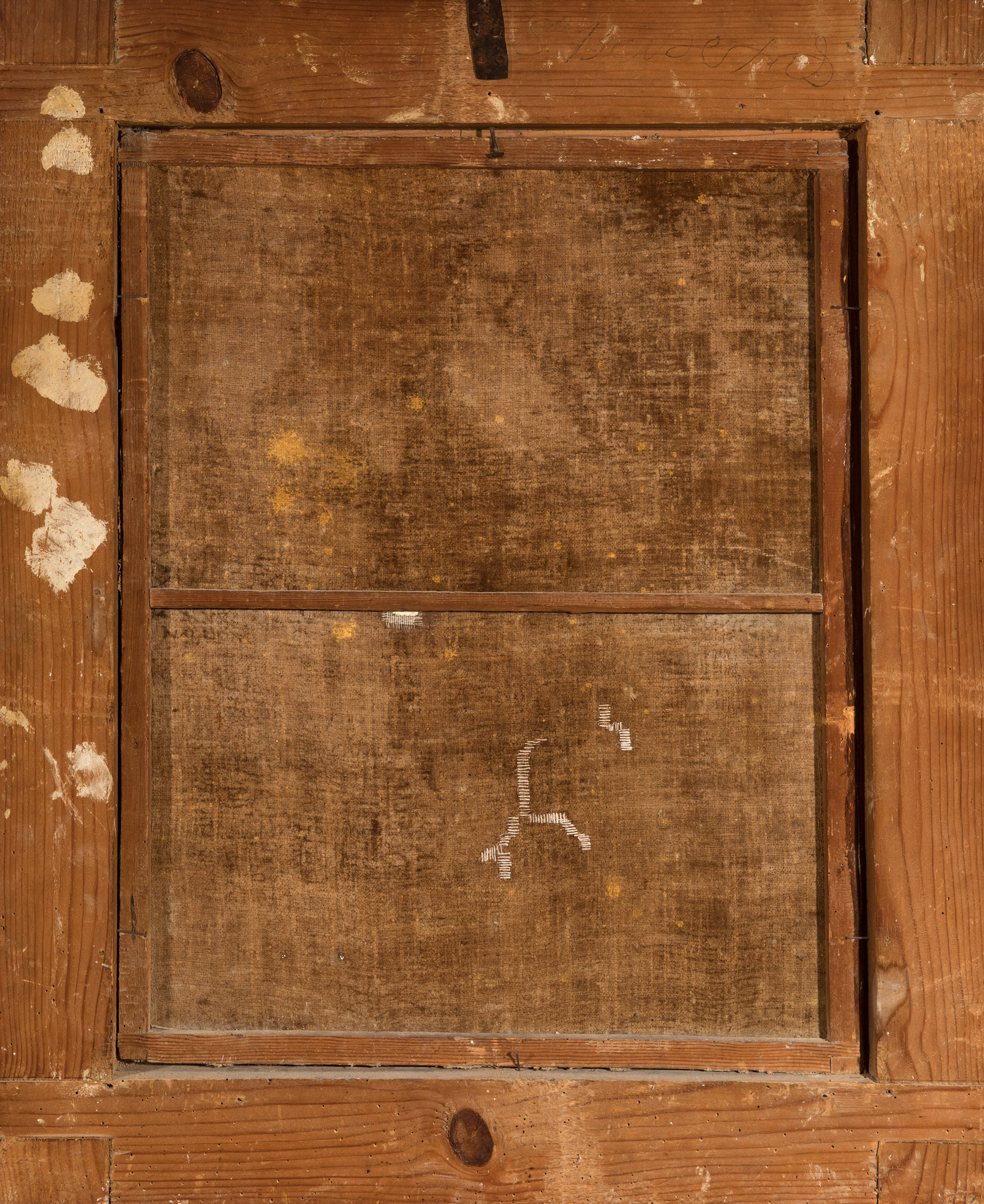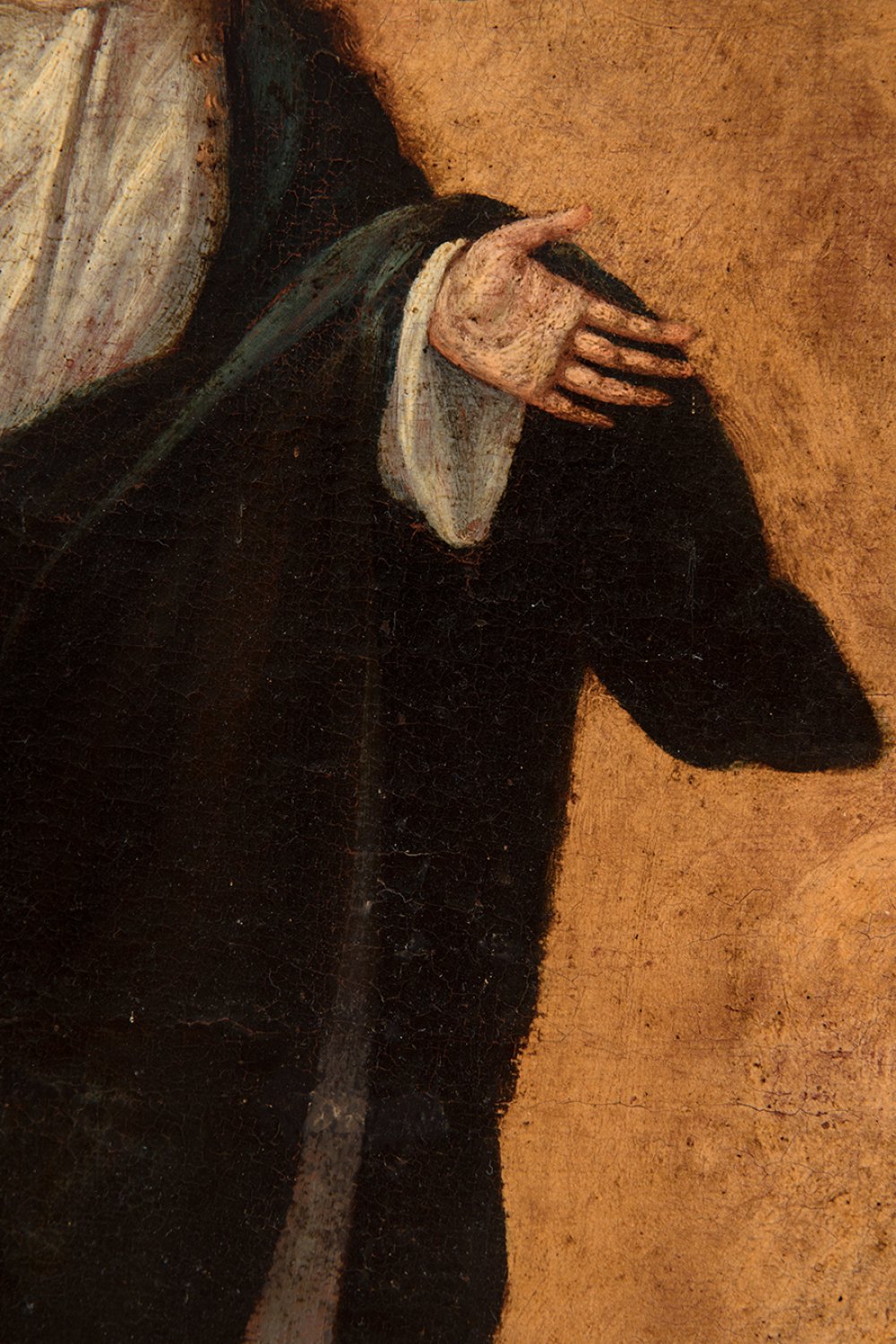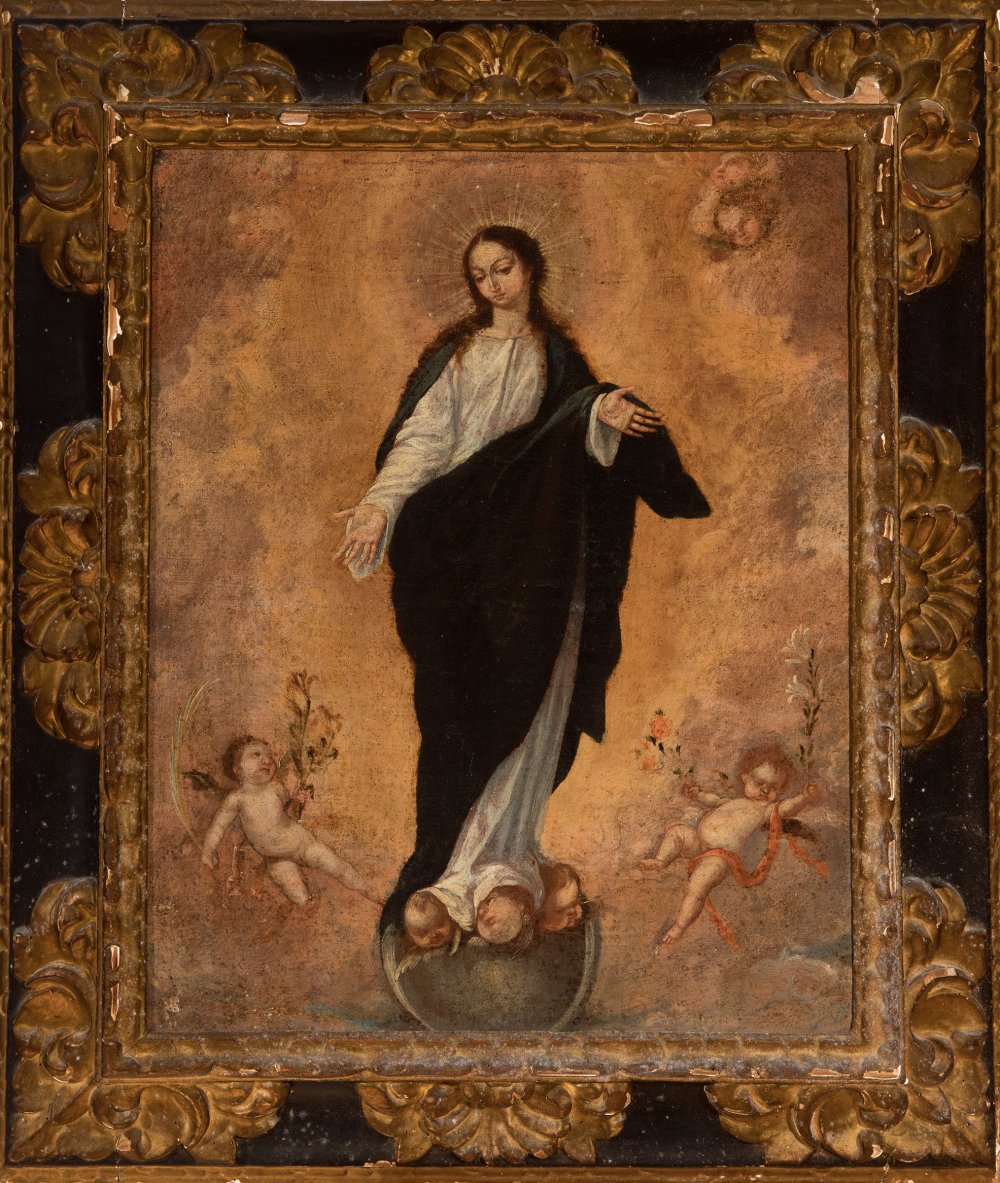5
Granada school; last third of the 17th century."Immaculate Conception".Oil on canvas.It presents
"Immaculate Conception".
Oil on canvas.
It presents restorations.
Preserves original canvas and important period frame.
Measurements: 63 x 50 cm; 81 x 68 cm (frame).
Representation of Mary as Immaculate with the figure in full body, standing on the lunar sphere. It is worth noting that the image dispenses with the usual litanies, with the body or image of the Virgin taking centre stage in the work. The artist depicts the Immaculate Conception in a more intimate manner without details that distort Mary's presence, adding only a number of little loves to the scene, which he places on the sides and in the lower part of the compassion. The artist plays with a delicate chromatic range in which gold has the greatest presence, thus adding warmth to the scene. However, the Virgin's dark cloak breaks with the unity of the neutral background, so that the figure of the Virgin acquires greater emphasis in the scene. In short, the author shows us a devotional image influenced by the aesthetics of painters such as Pedro de moya (Granada, c. 1610- 1674).
Medieval Christianity passionately debated the belief that Mary had been conceived without the stain of original sin. Some universities and corporations swore to defend this privilege of the Mother of God, several centuries before the First Vatican Council defined the dogma of faith in 1854. At the end of the Middle Ages the need arose to give iconographic form to this idea, and the model of the Apocalyptic Woman of Saint John was taken, maintaining some elements and modifying others (the Apocalyptic Woman is pregnant, but not the Immaculate). The definitive image came to fruition in the 16th century, apparently in Spain. Following a Valencian tradition, the Jesuit Father Alberro had a vision of the Immaculate Conception and described it to the painter Juan de Juanes so that he could depict it as faithfully as possible. It is an evolved iconographic concept, sometimes associated with the theme of the Coronation of the Virgin. Mary is shown standing, dressed in a white tunic and blue cloak, her hands crossed on her chest, with the moon at her feet (in memory of Diana's chastity) and treading on the infernal serpent (symbol of her victory over Original Sin). Around his head, like a halo, he wears the twelve stars, symbolic of fullness and alluding to the twelve tribes of Israel. Most of these images are accompanied in the painting by the Marian symbols of the litanies and psalms, such as the mystical rose, the palm tree, the cypress, the enclosed garden, the ark of Faith, the gate of Heaven, the ivory tower, the sun and moon, the sealed fountain, the cedar of Lebanon, the spotless mirror, the morning star, and so on. In Baroque painting, the background is usually celestial and populated with angels, as 17th-century artists faithfully maintained the iconographic type, but dispensed with the symbols of the litanies or reduced them, incorporating them into the composition in a naturalistic manner, and sought greater dynamism and a sense of theatricality.
"Immaculate Conception".
Oil on canvas.
It presents restorations.
Preserves original canvas and important period frame.
Measurements: 63 x 50 cm; 81 x 68 cm (frame).
Representation of Mary as Immaculate with the figure in full body, standing on the lunar sphere. It is worth noting that the image dispenses with the usual litanies, with the body or image of the Virgin taking centre stage in the work. The artist depicts the Immaculate Conception in a more intimate manner without details that distort Mary's presence, adding only a number of little loves to the scene, which he places on the sides and in the lower part of the compassion. The artist plays with a delicate chromatic range in which gold has the greatest presence, thus adding warmth to the scene. However, the Virgin's dark cloak breaks with the unity of the neutral background, so that the figure of the Virgin acquires greater emphasis in the scene. In short, the author shows us a devotional image influenced by the aesthetics of painters such as Pedro de moya (Granada, c. 1610- 1674).
Medieval Christianity passionately debated the belief that Mary had been conceived without the stain of original sin. Some universities and corporations swore to defend this privilege of the Mother of God, several centuries before the First Vatican Council defined the dogma of faith in 1854. At the end of the Middle Ages the need arose to give iconographic form to this idea, and the model of the Apocalyptic Woman of Saint John was taken, maintaining some elements and modifying others (the Apocalyptic Woman is pregnant, but not the Immaculate). The definitive image came to fruition in the 16th century, apparently in Spain. Following a Valencian tradition, the Jesuit Father Alberro had a vision of the Immaculate Conception and described it to the painter Juan de Juanes so that he could depict it as faithfully as possible. It is an evolved iconographic concept, sometimes associated with the theme of the Coronation of the Virgin. Mary is shown standing, dressed in a white tunic and blue cloak, her hands crossed on her chest, with the moon at her feet (in memory of Diana's chastity) and treading on the infernal serpent (symbol of her victory over Original Sin). Around his head, like a halo, he wears the twelve stars, symbolic of fullness and alluding to the twelve tribes of Israel. Most of these images are accompanied in the painting by the Marian symbols of the litanies and psalms, such as the mystical rose, the palm tree, the cypress, the enclosed garden, the ark of Faith, the gate of Heaven, the ivory tower, the sun and moon, the sealed fountain, the cedar of Lebanon, the spotless mirror, the morning star, and so on. In Baroque painting, the background is usually celestial and populated with angels, as 17th-century artists faithfully maintained the iconographic type, but dispensed with the symbols of the litanies or reduced them, incorporating them into the composition in a naturalistic manner, and sought greater dynamism and a sense of theatricality.
28th September - Old Masters
Sale Date(s)
Venue Address
General delivery information available from the auctioneer
Setdart offers Worldwide shipping
PICK UP IN ROOM: You can come and pick up your lots in our offices (Barcelona, Madrid or Valencia). At the moment of the withdrawal, you will be able to accept the current conditions of the lot by means of a document that you will sign.
YOU CAN SEND ANOTHER PERSON TO PICK UP: This person must present a signed authorization that you can find in our web page by accessing from BUY AT SETDART- LOGISTICS-DOWNLOAD AUTHORIZATION DOCUMENT. You can also send an e-mail with the requested data in AUTHORIZATION DOCUMENT to admin@setdart.com
Important Information
25% buyer´s premium
21% buyer´s premium at www.setdart.com
Terms & Conditions
The maximum period to pay the lots is 7 working days. You can pay either via bank transfer or with credit card through our platform www.setdart.com (we only accept VISA or Mastercard).
BUYER´S PREMIUM: 22% Hammer price + 21% VAT from the buyer´s premium
If your piece has more than 100 years, our Ministry of Culture requires an export certificate in order for the piece to leave the country. Note that if the piece goes inside the EU, there is no cost for the export certificate. If the piece goes outside the EU, there is a cost for the export certificate. You can find more information in our Ministry of Culture website: https://www.culturaydeporte.gob.es/en/cultura/patrimonio/exportacionimportacion/exportacion/tasas.html
INQUIRIES: admin@setdart.com
Setdart guides you through the entire process, from the time of award to the day you receive your lot. Our logistics team will be happy to manage your transport, and will advise you on the best shipping method with professionals from the sector used to handling works of art and jewelry.
WE OFFER WORLDWIDE DOOR TO DOOR SHIPPING
PICK UP IN ROOM: You can come and pick up your lots in our offices. At the moment of the withdrawal, you will be able to accept the current conditions of the lot by means of a document that you will sign.
YOU CAN SEND ANOTHER PERSON TO PICK UP: This person must present a signed authorization that you can find in our web page by accessing from BUY AT SETDART-LOGISTICS-DOWNLOAD AUTHORIZATION DOCUMENT. You can also send an e-mail with the requested data in AUTHORIZATION DOCUMENT to admin@setdart.com
SETDART IS NOT RESPONSIBLE FOR THE STATE OF THE PARTS ONCE THEY LEAVE OUR FACILITIES. MRW SHIPMENTS: Once the payment is made, your lot will be packed for shipment, the logistics department will send you an e-mail notifying you of the day it leaves our warehouse, changes of address cannot be made after receiving this e-mail.
INSURANCE INCIDENTS: Coverage for the value of the auction up to 3000 ? per shipment, if the value of the auction is higher, Setdart will send you a quote including the additional insurance. The insurance company WILL NOT BE RESPONSIBLE FOR THE SHIPMENT THAT EXCEEDS THAT AMOUNT AND IS NOT FULLY INSURED. MRW INCIDENTS: Maximum notification 48 hours after receipt, after which the insurance company WILL NOT BE RESPONSIBLE AND NO CLAIMS WILL BE ACCEPTED.
E-MAIL LOGISTICS: logistica@setdart.com
PICK UP YOUR MESSAGES: You can send your own messaging, prior notice via e-mail that your shipment is ready, please note 3 or 4 days in advance. This type of shipment is packaged so Setdart will provide you with a quote.
EXPENSES FOR STORAGE: We inform you that if the purchased lot is not picked up within a month, you will be charged 30€ per week per lot. Setdart Online S.L., owner of the web site "setdart.com", "setdart.net" and "setdart.org", acts as a company of Spanish nationality inscribed in the Volume 36955, sheet 182, page B-293056 of the Mercantile Registry, with registered office at Calle Aragó















